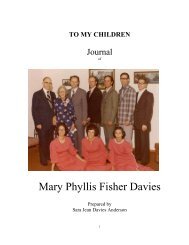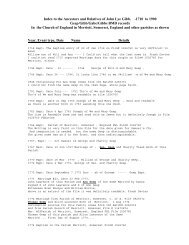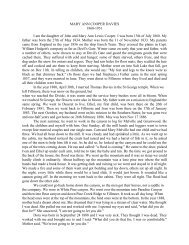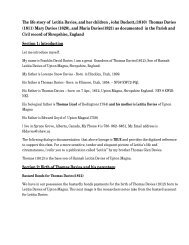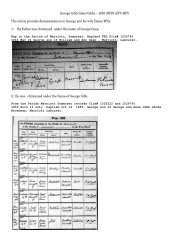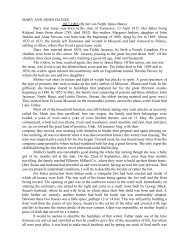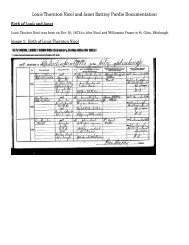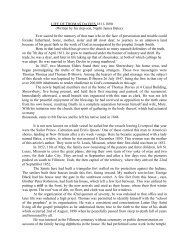LETITIA Oh Letitia! Were you an unfortunate victim ... - Thomas Davies
LETITIA Oh Letitia! Were you an unfortunate victim ... - Thomas Davies
LETITIA Oh Letitia! Were you an unfortunate victim ... - Thomas Davies
Create successful ePaper yourself
Turn your PDF publications into a flip-book with our unique Google optimized e-Paper software.
Mrs Stewart as her employer belonged to one of the most prestigious families of Shropshire.<br />
<strong>Letitia</strong> was a serv<strong>an</strong>t in Mrs. Stewart's home for about four years.<br />
To underst<strong>an</strong>d what happened to <strong>Letitia</strong>, it is import<strong>an</strong>t to know a little history 2 of Mrs.<br />
Stewart's family. Mrs. Catherine Stewart was the wife of Captain Gilbert Shuckburgh Stewart<br />
Esquire, captain of the 68th Regiment of Foot. She was also the daughter of Lord Cecil Forrester.<br />
The Forrester family was one of the most prestigious families in Shropshire. They held extensive<br />
property in Upton Magna <strong>an</strong>d other parts of Shropshire. Lord Cecil Forrester was the member of<br />
parliament for Much Wenlock, Shropshire <strong>an</strong>d his wife was the sister of the Duke of Rutl<strong>an</strong>d.<br />
The Forrester family circulated amongst the very highest of the nobility of Engl<strong>an</strong>d. Certainly,<br />
there were very few people from Shropshire with higher r<strong>an</strong>k.<br />
Mrs. Stewart also had a <strong>you</strong>nger brother named Fr<strong>an</strong>cis Forrester, the fifth son of Lord<br />
Cecil Forrester. He was christened at St. Chad’s in Shrewsbury 19 August 1774. He was a major<br />
of the 15th Hussars <strong>an</strong>d the Royal Horse Guards. On July 22, 1813, he married Lady Louisa<br />
Catherine Barbara V<strong>an</strong>e, eldest daughter of the Earl of Darlington <strong>an</strong>d first Duke of Clevel<strong>an</strong>d.<br />
At a later period after the time of which we speak, Fr<strong>an</strong>cis took his brother’s place as a member<br />
of parliament on the occasion of his older brother’s elevation to the peerage (Baron Cecil<br />
Forrester). Undoubtedly, Major Fr<strong>an</strong>ces Forrester visited his sister, Mrs. Stewart, a number of<br />
times <strong>an</strong>d on one of these visits, <strong>Letitia</strong> became pregn<strong>an</strong>t. It is not surprising that a <strong>you</strong>ng serv<strong>an</strong>t<br />
girl was flattered by the attention of a major in the army of such stature as Fr<strong>an</strong>ces Forrester. She<br />
must have been sufficiently pretty to attract his attention, as well, even if it was for all the wrong<br />
reasons. What happened to <strong>Letitia</strong> when this event became known is uncertain except that her<br />
employment with Mrs. Stewart was terminated. With no place to go <strong>an</strong>d with no me<strong>an</strong>s to<br />
support herself, she went to the house of Industry where she probably worked under very harsh<br />
conditions until her baby was born. Why she did not go home to her mother's place, five miles<br />
away (her father died just a few months previous to the birth of <strong>Letitia</strong>'s child) is not known<br />
except that settlements laws probably prohibited it. Thus it was at the house of Industry that she<br />
gave birth to her child which occurred on June 14, 1810. The child was a boy. At the house of<br />
Industry her confinement was not free as she was required to pay for two nurses for the delivery.<br />
<strong>Letitia</strong> did not have the money to pay for these services. In those days, as at other times, the<br />
community officers did not w<strong>an</strong>t to have illegitimate children of poor mothers thrown upon them<br />
for support. On orders of Mr. Joseph Asterley, the chairm<strong>an</strong> of the Board of the House of<br />
Industry, Fr<strong>an</strong>cis Forrester was solicited to determine what he would do to support the child. He<br />
agreed to pay to the house of Industry a sum of thirty guineas (30 lbs 10 shillings - ) in a lump<br />
payment with no further responsibility for the boy child. What happened to this child was not<br />
known until recently, nor did we know the child's name. What happened to <strong>Letitia</strong> next is also<br />
uncertain. She apparently returned to Upton Magna without the baby <strong>an</strong>d so it was assumed that<br />
the child had died. What trauma this experience caused <strong>Letitia</strong> we c<strong>an</strong> only imagine, nor do we<br />
underst<strong>an</strong>d clearly what shame <strong>an</strong>d hurt <strong>an</strong>d despair she had to endure. Accounts of similar<br />
occurrences of the time suggest that it was a very sad <strong>an</strong>d degrading experience. What is clear is<br />
that she could not support the child <strong>an</strong>d was therefore under the necessity to give it up.<br />
Recent documents* obtained from the parish of Condover, however, show that the child<br />
did not die but was raised by John Duckett <strong>an</strong>d his wife Sarah Wheeler. The parish record at<br />
Condover indicates that <strong>Letitia</strong>’s child was known as John Duckett. John Duckett was christened<br />
on October 11 1829 as <strong>an</strong> adult, the son of Fr<strong>an</strong>cis Forester esquire <strong>an</strong>d <strong>Letitia</strong> <strong>Davies</strong> serv<strong>an</strong>t.<br />
At the time of christening, he was nineteen years of age. It is ironical that the father was<br />
mentioned in the parish record holding the titles of his r<strong>an</strong>k <strong>an</strong>d <strong>Letitia</strong> was called a serv<strong>an</strong>t.



